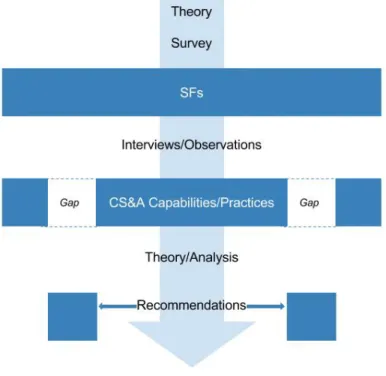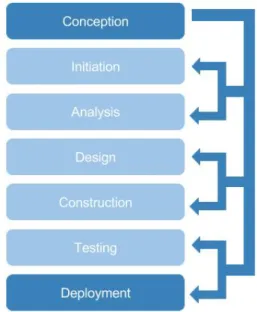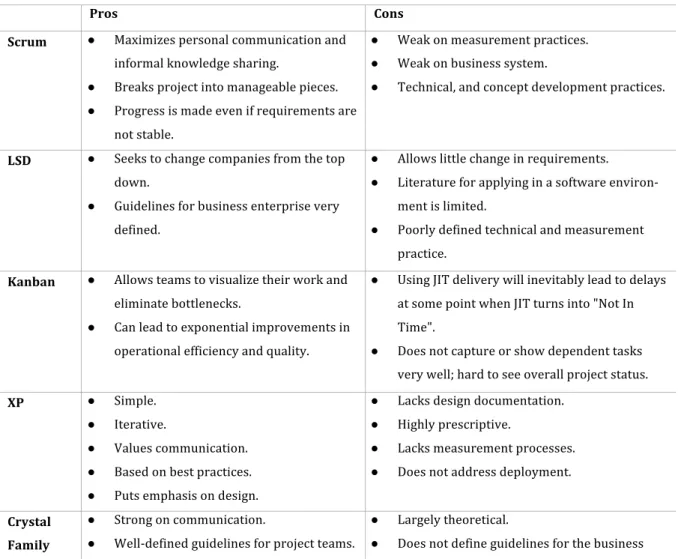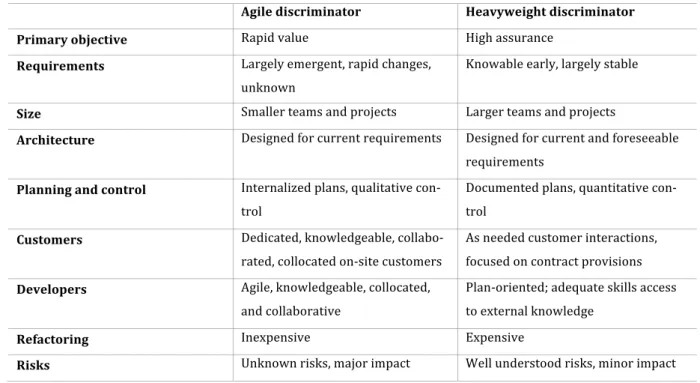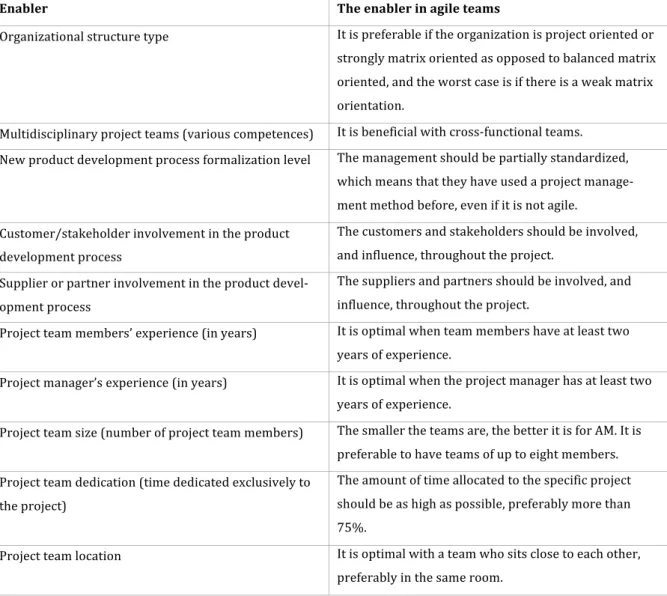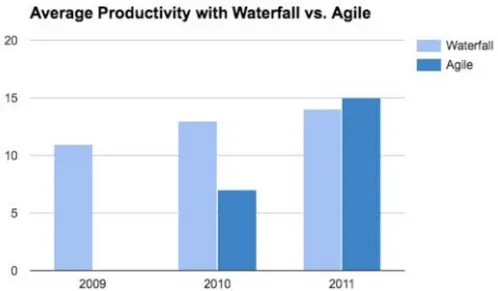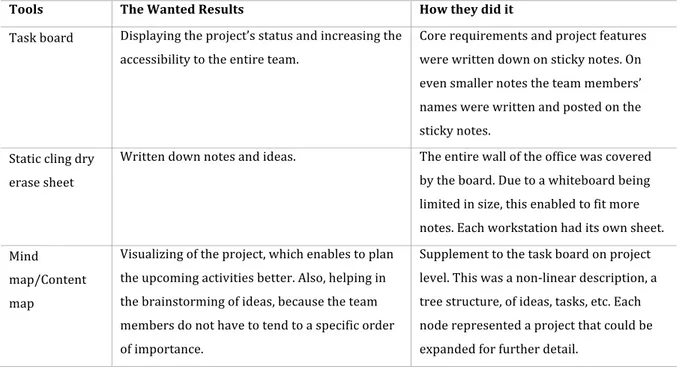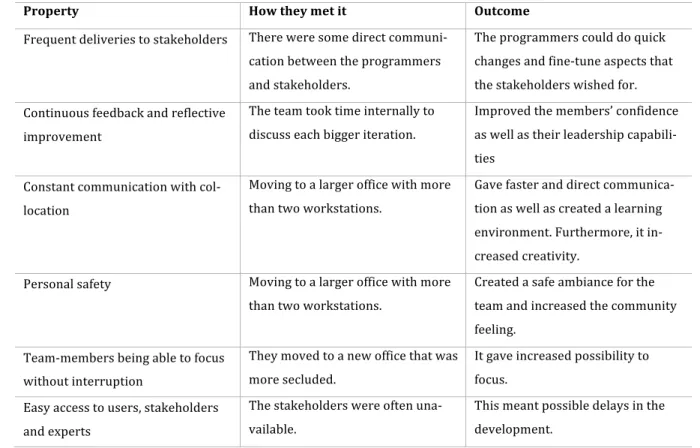Agile Management Outside of Software
Development
A Case Study of How Agile Management Should Be Used within a
Small Team at a Fast Growing Financial Institute
Authors: Kajsa Alenmyr & Antonia Nilsson Lund University 2016
Agile Management outside Software Development -‐ A Case Study of How Agile Manage-‐ ment Should Be Used within a Small Team at a Fast Growing Financial Institute
Copyright © 2016 Kajsa Alenmyr and Antonia Nilsson
Faculty of Engineering, Lund University Box 118
SE-‐22100 Lund Sweden
Preface
This Master Thesis was conducted during the spring of 2016 in collaboration with Klar-‐ na AB and is the final academic project of the authors, graduating from Industrial Engi-‐ neering and Management at Faculty of Engineering, Lund University. This project gave the authors insight in how to apply academic theory to a real case study as well as knowledge about the enablers and practices related to an agile work methodology. As the Master Thesis has combined the academic rigor of research with a real business problem it is the perfect bridge for the authors from being students to starting out their careers outside the university.
Acknowledgement
We would like to express our sincerest gratitude for the possibility to carry out this Master Thesis Project with the case company, Klarna AB. A special thanks to Wilhelm Back, Credit Risk Analyst at Credit Strategy & Analytics and our supervisor at Klarna AB, who has provided us with great insights during our project and always been available. We would also like to thank all team members at Credit Strategy & Analytics for wel-‐ coming us and being open and helpful during our entire project.
We would also like to thank everyone who answered our survey at other companies and who wrote us emails to give us information. It is obvious that the agile community is extremely helpful, which is something we are very thankful for.
Special thanks are of course also given to our supervisor, Bertil I Nilsson, for his guid-‐ ance, support, and for sharing great and important input throughout the entire project. Lastly, we would also like to thank our opponents, Anna Bökberg and Karl Hedlund, for their valuable input on our Master Thesis.
Lund, May 2016.
Kajsa Alenmyr Antonia Nilsson
Abstract
Title
“Agile Management outside Software Development -‐ A Case Study of How Agile Management Should Be Used within a Small Team at a Fast Growing Financial Institute”
Authors
Kajsa Alenmyr and Antonia Nilsson M.Sc. of Industrial Engineering and Management Faculty of Engineering, Lund University
Supervisors
Bertil I Nilsson
Department of Production Management Faculty of Engineering, Lund University
Wilhelm Back
Credit Strategy & Analytics Klarna AB
Background
Agile Management is a management method based on the principles behind Agile Software Development. Compared to Traditional Management, Agile Management is more iterative and is therefore suited for fast paced and unsecure environ-‐ ments. Even though agile is a fairly old methodology; there are few case studies outside the software industry. There are indi-‐ cations, though, that Agile Management can work for other industries, especially those similar to software. To be able to use agile, some enablers and practices exist according to theo-‐ ry that are important for agile to be successful. Klarna AB is a fast growing financial institute where some teams work with agile today. Credit Strategy & Analytics is one of these teams, which consists of seven members who wanted to explore whether this methodology could work for them.Purpose
The purpose of the Master Thesis Project was to examine how agile methodology can be used at Credit Strategy & Analytics at Klarna AB by defining Success Factors and conducting a case study. More specifically, the aim was to provide recommenda-‐ tions on how the team can exploit agile methods in order to enhance their results.
Research Questions
In order to serve the purpose of the Master Thesis Project, four research questions were formed. When they were answered the goal was attained.
RQ 1: What agile practices are proposed in theory and previ-‐ ous case studies?
RQ 2: What Success Factors does a team need to possess in order to benefit from working with agile compared to other management methodologies?
RQ 3: What are the gaps between the Success Factors and prac-‐ tices that a team ideally should have to benefit from working with agile and the capabilities and practices the case team cur-‐ rently has?
RQ 4: What can be done in order for the case team to fill the gaps mentioned in RQ3?
Delimitations
The case study was limited to analyzing, evaluating ongoing processes, and proposing recommendations to Credit Strategy & Analytics at Klarna AB in Stockholm. This means that no im-‐ plementation of the recommendations was prepared, conduct-‐ ed, or evaluated at the case team. The survey that was carried out only covered the basic enablers for working with agile and due to the time limitation of the Master Thesis Project, it was limited to 62 agile professionals.The time limitation of the Master Thesis Project was 20 weeks and any areas that were not covered are suggested as future research.
Methodology
The Master Thesis consisted of a theory review, a qualitative case study at Credit Strategy & Analytics at Klarna AB, and a quantitative survey with representatives outside the case company. Primary data was collected from the case study as well as the survey. Secondary data was found through a theory review as well as from previous case studies within the field. The case study consisted of unstructured interviews, observa-‐ tions, a survey, and in-‐depth interviews. The research has been conducted using an abductive approach and was carried out in an iterative manner to ensure good results in the end.
Conclusion
The Master Thesis Project came up with nine Success Factors for a team using agile. A Success Factor is an enabler the au-‐ thors consider to be of large importance to be able to benefit from using agile. These are: Flexibility, Acceptance, Manage-‐ ment Support, Understanding, Leadership, Small teams, Dedicat-‐ ed Stakeholders, Long-‐term perspective, and Collocation.
The Master Thesis Project also came up with recommenda-‐ tions for the case team based on these nine Success Factors together with theory and previous case studies regarding prac-‐ tices and tools. The recommendations for the case team’s agile strategy include adding an education about agile, both for new and current employees, creating competence cards for the team to increase competence visibility, become better at being on time for the short stand-‐up meetings, and start using Kan-‐ ban instead of Scrum.
The authors have also created an alternative recommendation for continued use of Scrum. The recommendations for the use of Kanban include stopping time estimating tasks, having slightly longer stand-‐ups where short planning sessions are included, and have a Kanban board with a continuous flow of work. The recommendations for the use of Scrum include add-‐ ing a Scrum master role in the team that changes between the team members every sprint, to plan for 70 instead of 80 hours in a sprint to have time for ad hoc assignments and meetings, and also to create tasks in a way so that they are possible to finish within a sprint of two weeks.
Keywords
Agile, Agile Management, Enabler, Kanban, Scrum, Sprint, Suc-‐cess Factor, Traditional Management, Financial Institute
Sammanfattning
Titel
“Agil styrning utanför programvaruutveckling -‐ en fallstudie av hur agil styrning bör användas i ett litet team på ett snabbt växande finansiellt institut”
Författare
Kajsa Alenmyr och Antonia Nilsson M.Sc. i Industriell ekonomi
Lunds tekniska högskola
Handledare
Bertil I Nilsson Produktionsekonomi
Lunds Tekniska Högskola, Lunds Universitet
Wilhelm Back
Credit Strategy & Analytics Klarna AB
Bakgrund
Agil styrning är en styrningsmetod som bygger på principerna bakom agil programvaruutveckling. Jämfört med traditionell styrning, är agil styrning mer iterativ och därför lämpad för osäkra miljöer med snabbt tempo. Även om agilt är en ganska gammal metod finns det få fallstudier utanför programvaruin-‐ dustrin. Det finns dock indikationer på att agil styrning kan fungera för andra branscher, särskilt de som liknar mjukvaru-‐ utveckling. För att använda agilt på ett framgångsrikt sätt finns det vissa möjliggörare och aktiviteter som framhävs i teorin som viktiga att tillämpa. Klarna AB är ett snabbväxande finans-‐ institut där vissa team arbetar med agilt idag. Credit Strategy & Analytics är ett av dessa team som består av sju medlemmar.De ville utforska om denna metodik skulle kunna fungera för dem som ett analytiskt team utanför programvaruutveckling.
Syfte
Syftet med rapporten var att undersöka hur agil styrning kan användas utanför programvaruutveckling på Credit Strategy & Analytics på Klarna AB. Mer specifikt var målet att ge rekom-‐ mendationer kring hur teamet bör använda agila metoder för att förbättra sina resultat.
Forskningsfrågor
För att möta syftet av examensarbetet formades fyra forsk-‐ ningsfrågor. När dessa frågor var besvarade var målet för upp-‐ satsen nått.
FF1: Vilka agila tillvägagångssätt föreslås inom teorin och tidi-‐ gare fallstudier?
FF2: Vilka “Success Factors” och tillvägagångssätt behöver ett team ha för att dra fördelar från att arbeta agilt jämfört med andra styrningsmetodiker?
FF3: Vad är gapen mellan de “Success Factors” och tillväga-‐ gångssätt som ett team bör besitta för att dra fördelar av att arbeta agilt, och de som fallstudieteamet besitter just nu? FF4: Vad kan göras för att fallstudieteamet ska fylla gapen som nämns i FF3?
Avgränsningar
Fallstudien var begränsad till att analysera, utvärdera på-‐gående processer och föreslå rekommendationer till Credit Strategy & Analytics på Klarna AB i Stockholm. Detta innebär att ingen implementation av rekommendationerna förbered-‐ des, genomfördes eller utvärderades på fallstudieteamet. En-‐ kätundersökningen som gjordes omfattade endast grundläg-‐ gande möjliggörare för att arbeta med agilt och pågrund av tidsbegränsningen av examensarbetet begränsades den till 62 personer som arbetar med agilt.
Tidsbegränsningen för examensarbete var 20 veckor och alla områden som inte täcktes av projektet föreslås som framtida forskning.
Metod
Examensarbetet bestod av en teorigenomgång, en kvalitativ studie på Credit Strategy & Analytics på Klarna AB, och en kvantitativ enkätundersökning med representanter utanför fallstudieföretaget. Primärdata samlades in från fallstudien och enkätundersökningen. Sekundärdata samlades in genom en teorigenomgång samt från tidigare fallstudier inom området. Fallstudien bestod av ostrukturerade intervjuer, observation-‐ er, en enkätundersökning och djupintervjuer. En abduktiv me-‐ tod användes och den utfördes på ett iterativt sätt för att sä-‐ kerställa goda resultat.
Slutsats
Examensarbete kom fram till nio “Success Factors” för ett team som använder agil styrning. En ”Success Factor” är en möjlig-‐ görare som författarna anser vara av stor vikt för att agil styr-‐ ning ska vara fördelaktigt. Dessa är: Flexibilitet, Acceptans, Ledningsstöd, Förståelse, Ledarskap, Små grupper, Dedikerade intressenter, Långsiktighet och Samlokalisering.
Examensarbete resulterade också i rekommendationer för fall-‐ studieteamet baserat på de nio “Success Factors” som tidigare bestämts, och teori samt tidigare fallstudier. Rekommendat-‐ ionerna om fallstudieteamets strategi för agil styrning inklude-‐ rar att ha en utbildning om agil styrning,
både för nyanställda och för nuvarande anställda, att skapa kompetenskort för teamet för att öka transparensen, bli bättre på att vara i tid till avstämningsmöten och börja använda Kan-‐ ban istället för Scrum.
Författarna har också skapat en alternativ rekommendation för fortsatt användning av Scrum. Rekommendationerna för användning av Kanban inkluderar att sluta tidsuppskatta upp-‐ gifter, ha något längre avstämningsmöten där ett kort plane-‐ ringsmöte ingår, och att ha en Kanbanboard med ett kontinu-‐ erligt flöde av uppgifter. Rekommendationerna för användning av Scrum är att inkludera en Scrum master-‐roll i teamet, vilken skulle rotera bland teammedlemmarna varje sprint, att pla-‐ nera för 70 i stället för 80 timmar i en sprint för att ha tid för ad hoc-‐uppdrag och möten, och även för att skapa uppgifter på ett sätt så att de är möjliga att avsluta inom en sprint på två veckor.
Nyckelord
Agilt, Agil styrning, Möjliggörare, Kanban, Scrum, Sprint, Suc-‐ cess Factor, Traditionell styrning, Finansiellt institut
Table of Contents
1 INTRODUCTION ... 1
1.1 BACKGROUND OF THE STUDY ... 1
1.1.1 Theoretical Background ... 1
1.1.2 Background of Klarna AB ... 2
1.2 PROBLEM ... 3 1.3 PURPOSE ... 3 1.4 RESEARCH QUESTIONS ... 3 1.5 DELIMITATIONS ... 4 1.6 REPORT OUTLINE ... 4 2 METHODOLOGY ... 7 2.1 RESEARCH STRATEGY ... 7 2.2 RESEARCH DESIGN ... 7 2.3 DATA COLLECTION ... 8 2.3.1 Observations ... 9 2.3.2 Semi-‐Structured Interviews ... 9 2.3.3 Survey ... 11 2.4 DATA ANALYSIS ... 12 2.5 WORK PROCESS ... 13
2.5.1 The Qualitative Research Cycle ... 13
2.5.2 Literature Review ... 14
2.5.3 Benchmarking Against Work from Other Agile Professionals ... 14
2.5.4 Case Study at CS&A ... 14
2.5.5 Analyzing and Identifying Data to Create Recommendations ... 15
2.6 CREDIBILITY ... 16 2.6.1 Validity ... 16 2.6.2 Reliability ... 17 2.6.3 Transferability ... 18 3 THEORY ... 21 3.1 TM ... 21 3.1.1 What is TM? ... 21 3.2 AM ... 23
3.2.1 What is AM? ... 23
3.2.2 History ... 26
3.2.3 Agile Methods ... 27
3.2.4 Agile Support Systems ... 35
3.2.5 Agile outside Software Development ... 35
3.3 COMPARISON BETWEEN AM AND TM ... 36
3.4 ENABLERS FOR CHANGING MANAGEMENT METHODS ... 38
4 PREVIOUS CASE STUDIES ... 41
4.1 INCREASED PRODUCTIVITY WHEN GOING ALL-‐IN ... 41
4.2 AGILE IN LIBRARY IT INNOVATIONS ... 43
4.3 FROM SCRUM TO KANBAN AT STORMPATH ... 46
4.4 AGILE LEGAL TEAM AT THE LONELY PLANET ... 47
5 FINDINGS ... 51
5.1 FINDINGS FROM SURVEY ... 51
5.2 FINDINGS FROM CASE STUDY AT KLARNA ... 52
5.2.1 Observations ... 52
5.2.2 Interviews ... 54
5.3 FINDINGS OF ENABLERS ... 60
5.3.1 Enablers from the Survey ... 60
5.3.2 Enablers from Previous Case Studies ... 61
5.3.3 Enablers from Theory ... 63
5.3.4 The Nine SFs ... 64
6 ANALYSIS ... 67
7 CONCLUSION ... 75
7.1 ANSWERS TO RESEARCH QUESTIONS ... 75
7.2 RECOMMENDATION ... 76
7.2.1 General Recommendation ... 76
7.2.2 Recommendation for Kanban ... 77
7.2.3 Recommendation for Scrum ... 78
8 DISCUSSION ... 79
8.1 CONTRIBUTION TO THE ACADEMIA ... 79
8.2 GENERAL CONTRIBUTION ... 79
8.3 FURTHER WORK RECOMMENDATIONS ... 80
REFERENCES ... 82
APPENDIX ... 87
APPENDIX 1 -‐ INTERVIEW GUIDE ... 87
APPENDIX 2 -‐ SURVEY WITH OTHER COMPANIES AND CS&A ... 92
APPENDIX 3 -‐ THE 41 ENABLERS SUGGESTED BY CONFORTO ET AL. ... 98
APPENDIX 4 -‐ RESULTS FROM SURVEY WITH OTHER COMPANIES ... 99
APPENDIX 5 -‐ LONG TEXT ANSWERS FROM SURVEY ... 114
APPENDIX 6 -‐ COMPETENCE CARD ... 115
List of Figures
Figure 1. The Methodology of the Master Thesis Project.
Figure 2. A visualization of the data collected in the Master Thesis Project. Figure 3. The work-‐flow in TM, figure adapted from Lotz (2013).
Figure 4. The work-‐flow in AM, figure adapted from Lotz (2013).
Figure 5. Average productivity over time using waterfall methods or agile methods for a
specific large technical company, figure adapted from Putnam (2014).
Figure 6. The nine success factors that the authors came up with during the Master
Thesis Project.
Figure 7. The recommendations for CS&A’s agile strategy.
List of Tables
Table 1. Pros and cons with seven different agile methodologies, table adapted from
OPS International LLC (2015).
Table 2. A comparison between agile and heavy methods based on different factors,
table adapted from Awad (2005).
Table 3. Agile and heavyweight discriminators, table adapted from Awad (2005). Table 4. The six practices within agile teams, table adapted from Conforto et al. (2014). Table 5. A description of the ten most important enablers for AM and what they look
like in agile teams, table adapted from Conforto et al. (2014).
Table 6. The tools used in the study of Chang (2010).
Table 7. The six first properties of Crystal and how they were met in the case study of
Chang (2010).
Table 8. The agile methodologies applied by Lonely Planet Legal Affairs, table adapted
from Sullivan (2013).
Table 9. The business challenges that the legal team at Lonely Planet were facing and
how the results changed after implementing an agile model, table adapted from Sullivan (2013).
Table 10. Correlations between the factors brought up in the survey questions and
Glossary and Acronyms
Glossary
Master Thesis Report Definitions
The following expressions are defined by the authors of the Master Thesis Report and explain how the words are used in the report. Thus, they might at some point differ from the general agreed-‐upon definition.
Ad hoc assignment An assignment that is not included in the product back-‐
log.
Agile management The alternative methodology to traditional management
Enabler A condition found in theory that enables agile.
Jira Jira Software
Klarna Klarna AB
Management Both project management and process management is
covered in this word.
Master thesis project The project carried out by the authors that is described in this report.
Master thesis report This report.
Process management Ongoing work without a limited time-‐frame.
Project management Work with a clear outcome and a limited time-‐frame.
Success factor One of the nine enablers that the authors claim to be the most important.
Agile Definitions
The following expressions are used in the agile society and in the Master Thesis Report. They might not be known by a reader who is not familiar with the subject and are there-‐ fore explained in advance.
Acceptance criteria The criteria that defines the features of a task in order for a product owner or customer to accept it (Glossary n.d.).
Acceptance testing The test that determines whether a system meets the
needed requirements. It is usually expressed as an exam-‐ ple or a usage scenario (Guide to Agile Practices n.d.). Agile coach role A person that helps the team adopt and improve agile
methods and practices (Kelly 2009).
Backlog The list of features and tasks that are on the team’s agen-‐
da. This is where the tasks are prioritized and the tasks with the highest priority in the backlog are the ones han-‐ dled first (Guide to Agile Practices n.d.).
Backlog grooming The team meets regularly to “groom” the product backlog,
meaning removing user stories that are no longer rele-‐ vant, creating new tasks from discovered needs or cor-‐ recting estimates of tasks (Guide to Agile Practices n.d.).
Burndown chart A chart which tells the team the quantity of work remain-‐
ing on one axis, and the time elapsed on the other (Guide to Agile Practices n.d.).
Coding standards Programmers use the same standards when they create
the code. This makes it easier to refactor, extend, and maintain the code (Coding Standard n.d.).
Collective code ownership Every team member is allowed to change any code file that the team is working with (Guide to Agile Practices n.d.).
each integration stage, as well as being able to deliver a product version at any moment. This is achieved through the use of specific tools (Guide to Agile Practices n.d.).
Epic A story that represents a large story or set of features,
which is further described by user stories (Glossary n.d.).
Estimation The quantified evaluated measure of the time needed to
carry out a given task (Guide to Agile Practices n.d.). Interactive facilitated workshops A facilitator will be a part of a workshop with the aim to
create good conditions for effective group processes (Guide to Agile Practices n.d.).
Kanban board The visual board where all tasks are handled and moved
when they change status. Can be both offline on a white-‐ board, or online in a software system (Guide to Agile Practices n.d.).
Metaphor When a team within extreme programming creates a vi-‐
sion of how the program works through a metaphor. For example “this program works like a hive of bees, going out for pollen and bringing it back to the hive” (Metaphor n.d.).
MoSCoW An acronym used to prioritize work, or aspects of a spe-‐
cific task. Stands for must have, should have, can have, and will not have (Glossary n.d.).
Pair programming Two programmers work together and share the same
workspace, where one is the “driver” and one the “naviga-‐ tor”. They are expected to switch roles every five minutes (Guide to Agile Practices n.d.).
Planning game The main planning process of the extreme programming
method. The game is a meeting that takes place once eve-‐ ry iteration, typically once a week (Planning Game n.d.).
Prioritizing Agile teams rely on a prioritized backlog. Every task that goes into the backlog is prioritized relative to the other tasks (Prioritizing the Backlog n.d.).
Product owner role A role in an agile team who is responsible for collecting and prioritizing tickets in the backlog (Glossary n.d.).
Refactoring Consists of improving the internal structure of a program,
while keeping the program’s external behaviour (Guide to Agile Practices n.d.).
Retrospective The team meets to discuss and reflect on the most im-‐
portant events during an iteration, and how to be able to improve in future iterations (Guide to Agile Practices n.d.).
Scrum master A person whose role is to be the interface between the
product owner and the development team. The Scrum master is responsible for daily coordination meetings as well as facilitating the development process and ensuring that the team uses the full range of appropriate agile val-‐ ues, practices and rules (Bass 2014).
Simple design A software design strategy based on a few basic princi-‐
ples (Guide to Agile Practices n.d.).
Small, frequent releases An agile team frequently releases the product to the end-‐ user and listens to feedback (Guide to Agile Practices n.d.).
Sprint/Iteration A short period of time where the actual work takes place.
The time frame is usually between one and four weeks (Guide to Agile Practices n.d.).
Stand-‐up meeting A short meeting where the team meet and bring everyone
up to speed on what they are doing, what they are going to do, and obstacles that they might have found (Guide to Agile Practices n.d.).
Sustainable pace The team uses a work-‐pace that could be used for an un-‐ limited amount of time (Guide to Agile Practices n.d.).
Task A smaller part of a user story (Agile Dictionary n.d.).
Task board Similar to a Kanban board, but a task board is reset in the
beginning of every iteration (Guide to Agile Practices n.d.).
Test-‐driven development A style of programming where coding, testing, and design
are tightly integrated (Guide to Agile Practices n.d.).
Ticket The task in the backlog. It should have progress status, a
time estimation of the task and type, such as story, epic, etc. (Mr W Back 2016, pers.comm., 8 February).
User story A set of acceptance criteria needed in order to deliver a new feature or work. Commonly written as: As an X, I want to Y, so that Z. A user story is further described in tasks (Glossary n.d.).
WIP-‐limits WIP-‐limits determine the minimum and maximum
amount of work allowed in each status of a workflow. Reduces the amount of work nearly done by letting the team focus on a small number of tasks (Wip Limits n.d.).
Acronyms
AM Agile Management
ASD Agile Software Development
CR Credit Risk
CS&A Credit Strategy & Analytics
DSDM Dynamic Systems Development Method
FDD Feature-‐Driven Development
IU Implementation Unit
LSD Lean Software Development
QSM Quantitative Software Management Inc.
SF Success Factor
TM Traditional Management
WIP Work In Progress
XP Extreme Programming
1 Introduction
This chapter initiates the study by presenting the background of the Master Thesis Project, the underlying problem description, and research questions. Additionally, the chapter pre-‐ sents the purpose of the Master Thesis Project together with delimitations, deliverables, and an outline of the report.
1.1 Background of the Study
1.1.1 Theoretical Background
Agile Management (AM) is a management methodology based on the principles behind Agile Software Development (ASD). ASD was sprung from the Agile Manifesto in 2001 where 17 developers created and signed it (What is Agile? n.d.). The Agile Manifesto is based on four basic principles. Firstly, it stresses the importance of valuing individuals and interactions over processes and tools. Secondly, a working software is more im-‐ portant than a comprehensive documentation. Thirdly, collaboration with the custom-‐ ers outweigh the importance of contract negotiation. Lastly, responding to change is prioritized rather than following a predefined plan (Fowler & Highsmith 2001).
AM is an alternative to Traditional Management (TM). In TM, almost everything is planned before the execution of the work. Once the work is done, there will not be any revisions of the outcomes. A common method within TM is the waterfall method, which symbolizes the inability of moving up the waterfall (Hass 2007).
Even though agile is a fairly old technique within software development, there are few case studies made outside the software industry. There are indications, though, that AM is easiest implemented in areas similar to software development, such as product de-‐ velopment (Conforto et al. 2014). Agile companies are those that combine stability and speed, which means that the terms are not contradicting as some argue (Bazigos, De Smet & Gagnon 2015). Bazigos, De Smet & Gagnon (2015) showed in a study that agile companies have a better long-‐term health.
In order to succeed when implementing any new management method, some enablers need to be fulfilled. A few of them are general and similar for many methods, while oth-‐ ers differ. Conforto et al. (2014) have discovered some enablers, internal and external factors, making it beneficial to use AM over TM. They are factors such as the structure of the company, the size and location of the team, and the involvement of stakeholders (Conforto et al. 2014).
1.1.2 Background of Klarna AB
Klarna AB (Klarna) was founded in Stockholm 2005 with the business idea to simplify buying (About Us n.d.). Klarna is a financial institute offering invoices and partial pay-‐ ments to customers when they shop online. As of 2015, Klarna has a total of 45 million end-‐users (Klarna Statistics n.d.).
The case team belongs to the department Credit Risk (CR), which mainly works with the departments Commercial and Engineering. Some of the departments at Klarna work with AM, primarily the teams working with software development, but also some teams at CR (Mr. W Back 2016, pers.comm., 8 February).
Within CR, there is a team called Credit Strategy & Analytics (CS&A). This team decides on limits for purchases in different countries (Mr. W Back 2016, pers.comm., 8 Febru-‐ ary). It consists of seven people where the vast majority has been in the team shorter than six months. CS&A has worked with agile for a short period of time, more specifical-‐ ly since November 2015, and is still trying to find the right approach to use it (Mr. J Olesen 2016, pers.comm.. 17 February).
A team member found that CS&A had no clear deadlines and lack of focus and therefore suggested implementing AM. The aim of the implementation for CS&A was primarily to increase structure and visibility, as well as to facilitate prioritization between, and own-‐ ership of, different tasks (Mr. J Olesen 2016, pers.comm., 17 February). The team works with sprints of two weeks, planning sessions of one hour, stand-‐ups of approximately ten minutes every other day, and retrospectives of one hour at the end of a sprint. To make the work visible for all members of the team they use the software tools Jira Soft-‐ ware (Jira) and Confluence by Atlassian (Mr. W Back 2016, pers.comm., 8 February).
1.2 Problem
The problem is twofold: there is a small amount of knowledge of AM outside software development, and especially case studies within this field (Conforto et al. 2014), and CS&A has a need of further developing their work methodology. This Master Thesis Re-‐ port will therefore contribute to academia as it increases the amount of case studies on agile outside software development. It also means that there needs to be a combination of literature studies and own research to find the Success Factors (SFs) and the optimal solution for CS&A.
As CS&A has recently started to use AM they first need to know if it is the right method-‐ ology for them to use and secondly, how to use it optimally. The aim is to find SFs to de-‐ cide if CS&A has what is needed for AM to be as beneficial as possible, and to find reme-‐ dies where there are gaps between the case team’s present capabilities and the SFs.
1.3 Purpose
The purpose of the Master Thesis Project was to examine how agile methodology can be used at Credit Strategy & Analytics at Klarna AB by defining Success Factors and con-‐ ducting a case study. More specifically, the aim was to provide recommendations on how the team can exploit agile methods in order to enhance their results.
1.4 Research Questions
In order to serve the purpose of the Master Thesis Project, four research questions were formed. When they were answered the goal was attained.
RQ 1: What agile practices are proposed in theory and previous case studies?
RQ 2: What Success Factors does a team need to possess in order to benefit from work-‐ ing with agile compared to other management methodologies?
RQ 3: What are the gaps between the Success Factors and practices that a team ideally should have to benefit from working with agile and the capabilities and practices case team currently has?
RQ 4: What can be done in order for the case team to fill the gaps mentioned in RQ3?
The first question was answered through a literature review of theory and case studies within the subject. To be able to answer the second question a survey was created and sent out to professionals who have experience of working with AM. The survey investi-‐ gated their enablers for working with agile. The survey was created through combining theory from literature and inferences of that literature. The third question was treated through conducting observations and interviews with CS&A. The interviews were based partly on following up the survey, which the team answered in beforehand, and partly on understanding the current situation in the team. The fourth question was answered through an abductive approach combining the research of the first two questions and conducting an analysis of these.
1.5 Delimitations
The case study was limited to proposing recommendations to CS&A at Klarna in Stock-‐ holm. This means that no implementation of agile methodology was prepared, conduct-‐ ed, or evaluated at the case company. The survey carried out only covered the basic en-‐ ablers for working with agile and due to the time limitation of the Master Thesis Project it was limited to 62 professionals working with agile.
The time limitation for the Master Thesis Project was 20 weeks and any areas that are not covered will be suggested as future research.
1.6 Report Outline
Chapter 1 Introduction
This chapter initiates the study by presenting the background of the Master Thesis Pro-‐ ject, the underlying problem description, and research questions. Additionally, the chap-‐ ter presents the purpose of the Master Thesis Project together with delimitations, deliv-‐ erables, and an outline of the report.
Chapter 2 Methodology
The following chapter will describe the methodology of the Master Thesis Project and Report. It will handle the rationale of the research, data collection and analysis. Lastly, it will discuss the credibility through parameters such as validity, reliability and transfer-‐ ability.
Chapter 3 Theory
This chapter introduces AM and TM by presenting the history, methods, practices, and when to use the different methods. There is also a comparison between the two man-‐ agement methods.
Chapter 4 Previous Case Studies
This chapter brings up some previous case studies made in the field of AM, both within, and outside of software development. The challenge, methodology implemented, results and conclusion from the different studies are presented.
Chapter 5 Findings
In this chapter the findings from the case study at CS&A and the survey to other profes-‐ sionals working with agile will be shown. There will also be an aggregation of all ena-‐ blers found in the theory, external case studies, and the survey with a conclusion of the final nine SFs.
Chapter 6 Analysis
This chapter includes a discussion about the current situation at CS&A, what is good as it is and where gaps exist between the team’s method and best practice. All facts that do not have a reference come from the findings of the Master Thesis Project.
Chapter 7 Conclusion
In this chapter the analysis will be synthesized into a conclusion of the research ques-‐ tions and recommendations are formed to CS&A about how they can improve their work in order to become best practice.
Chapter 8 Discussion
In this chapter there is a discussion about how the Master Thesis Project has contribut-‐ ed to the academia, the chosen methodology, and propositions for further work within the subject.
2 Methodology
The following chapter will describe the methodology of the Master Thesis Project and Re-‐ port. It will handle the rationale of the research, data collection and analysis. Lastly, it will discuss the credibility through parameters such as validity, reliability and transferability.
2.1 Research Strategy
When creating this Master Thesis Project, the authors used a qualitative research strat-‐ egy together with an abductive reasoning approach.
An abductive research approach was chosen instead of inductive and deductive reason-‐ ing. It differs from the deductive and inductive approach as they focus on finding rela-‐ tions between known structures. In abductive research, the researchers go from estab-‐ lished knowledge to new knowledge, by observing something that cannot be explained by existing theories and best practices. The deductive approach is about reviewing the literature, and then creating hypotheses and propositions that are tested in a research setting. The inductive approach, on the other hand, uses observations to form proposi-‐ tions, without consulting the literature (Kovacs & Spens 2005).
The abductive approach is more focused on specific situations that might deviate from the rule, than on generalizations (Kovacs & Spens 2005). The method was appropriate for the Master Thesis Project, as it revolved around a case study. It was therefore im-‐ portant for the researchers to recognize which of the findings that could be generalized and form propositions to the theoretical rule, and which ones that were specific to the situation (Kovacs & Spens 2005). Furthermore, in abductive research the data is collect-‐ ed at the same time as the theory is built, which supports working in iterations (Kovacs & Spens 2005). This was suitable as the research is about agile.
2.2 Research Design
A case study constituted the main part of the Master Thesis Project. According to Yin (2014), case studies are a good approach when the phenomena researched might be hard to distinguish from its context. The design of a case study is flexible, and questions
and directions can be revised during the course of the study. The data collected in the study is mainly qualitative (Höst, Regnell & Runeson 2006).
To complement the case study, a literature study and survey was conducted. As men-‐ tioned, data collection was conducted at the same time as the analysis. This enabled the authors to use the gathered data and reiterate when further depth in the analysis was needed. The data collected was compared to the theory in order to find similarities and differences, which could be used in the further iterations of the Master Thesis Project.
2.3 Data Collection
There are two main research strategies, qualitative and quantitative (Höst, Regnell & Runeson 2006). The difference between qualitative and quantitative research strategy is not always entirely clear. Qualitative research is a good strategy when gathering in-‐ formation about for example underlying attitudes (Lekvall & Wahlbin 2001). The strat-‐ egy enables more depth of detail in the participants’ experiences (Hennink, Hutter & Bailey 2011). This suited the study well as it was meant to understand the underlying enablers to the fitness of working with agile. Furthermore, a qualitative strategy is beneficial when researching a relatively young subject (Starrin & Svensson 1994), which the Master Thesis Project was doing. Quantitative research, however, is when the results from the study is presented in numbers and can be analyzed using statistical calculations (Lekvall & Wahlbin 2001).
The case study consisted of semi-‐structured interviews and observations, and to com-‐ plement that information a survey and literature review was conducted. The semi-‐ structured interviews were chosen, as they tend to give more information about a topic, than focus groups do (Jamshed 2014). Also, there is a risk that a few more dominant respondents will dominate the discussion, not letting opinions of everyone through. The advantage of using focus groups is that it may create a group dynamic, which can make the participants talk about attitudes and opinions that the individual interviews would not have brought up (Lekvall & Wahlbin 2001). However, the authors decided that the individual interviews were preferable.
2.3.1 Observations
When conducting observations the researcher observes an event, and notes the se-‐ quence of the things happening (Robson 2002). It is a good method for confirmation and complementary data gathering (Jamshed 2014). This is also how the method was used, together with the interviews. In most observations conducted, the authors were com-‐ plete observers, meaning that they participated in the event as little as possible. Howev-‐ er, they were still present in the room where the event took place and took notes visibly. By not partaking in the events, the authors ensured that they would influence the event minimally (Höst, Regnell & Runeson 2006). The events that the authors observed were sprint planning meetings, stand-‐up meetings and retrospectives.
2.3.2 Semi-‐Structured Interviews
Semi-‐structured interviews are in-‐depth interviews with an interview guide that has predefined questions and open-‐ended answers. In general, these interviews are be-‐ tween 30 minutes and up to over an hour (Jamshed 2014), which was also the case in the Master Thesis Project. The interview guide is a beneficial tool as it helps explore the subject more systematically, and thereby increases the efficiency and effectiveness of the interview. Furthermore, the interview guide is centered around a few core ques-‐ tions, which in turn have a few follow-‐up questions on the topic. It is suggested to have a test interview before having the actual interviews as the interviewers will have the pos-‐ sibility to further improve the interview guide (Jamshed 2014). Jamshed (2014) sug-‐ gests recording the interviews, as it is more reliable than just having hand-‐written notes. The authors chose to both collect data through using a recorder and taking notes.
All interviews were conducted face-‐to-‐face as it is supposed to give the interview better dynamics than for example using phone interviews (Lekvall & Wahlbin 2001). Also, the interviews were longer than 30 minutes, which exceeds the suggested time limit for phone interviews (Lekvall & Wahlbin 2001).
Pre-‐Interviews with Key Information-‐Holders
In order to gather basic knowledge about Klarna, the agile initiative at CS&A, and agile work at Klarna in general, interviews were conducted with different key information-‐
